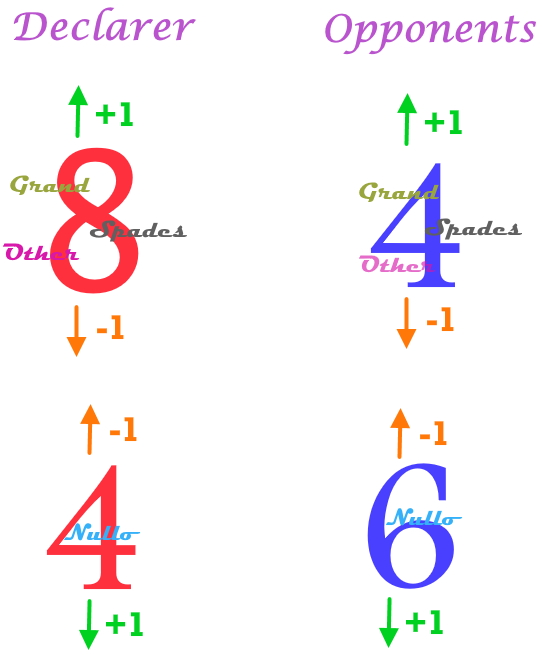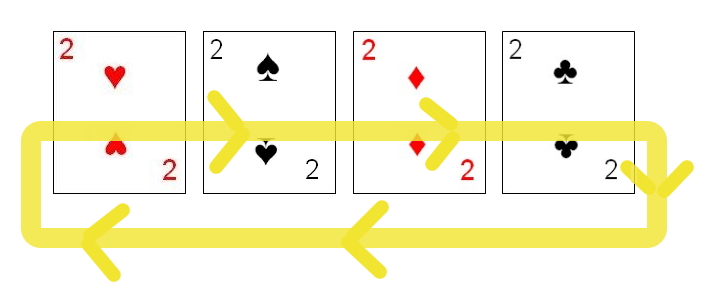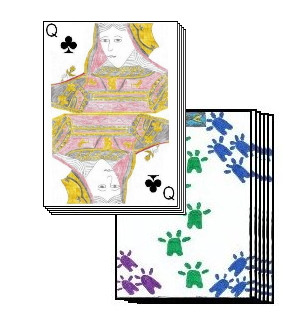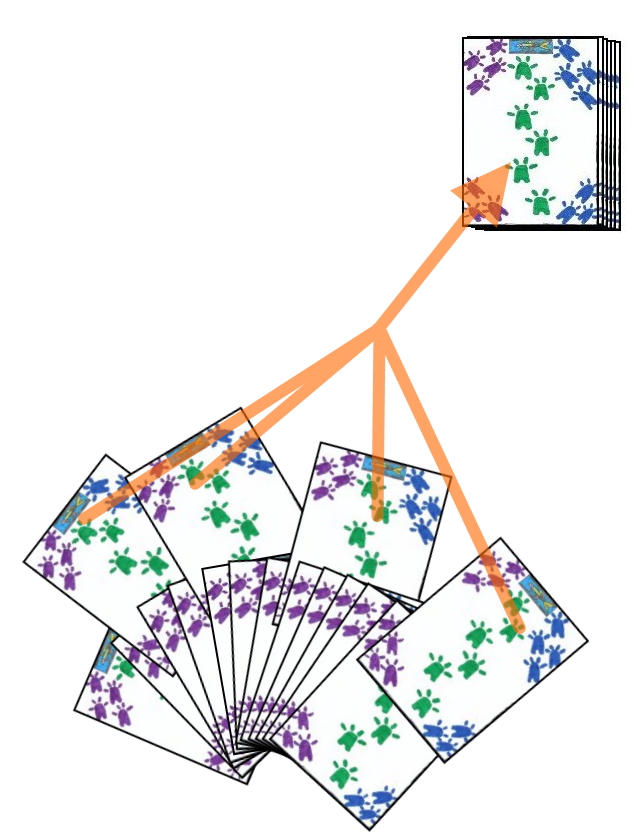| Game Type | Declarer's Scoring | Opponent's Scoring |
|---|
| Grand | 1 positive point for each trick won above eight
1 negative point for each trick less than eight won | 1 positive point for each trick won above four
1 negative point for each trick won fewer than four |
|---|
| Spades (♠) | 1 positive point for each trick won above eight
1 negative point for each trick less than eight won | 1 positive point for each trick won above four
1 negative point for each trick won fewer than four |
|---|
| Hearts (♥) | 1 positive point for each trick won above eight
1 negative point for each trick less than eight won | 1 positive point for each trick won above four
1 negative point for each trick won fewer than four |
|---|
| Diamonds (♦) | 1 positive point for each trick won above eight
1 negative point for each trick less than eight won | 1 positive point for each trick won above four
1 negative point for each trick won fewer than four |
|---|
| Clubs (♣) | 1 positive point for each trick won above eight
1 negative point for each trick less than eight won | 1 positive point for each trick won above four
1 negative point for each trick won fewer than four |
|---|
| Great Grand | If declarer wins all 15 tricks, 4 positive points are earned by declarer
If declarer wins all 16 tricks, 8 positive points are earned by declarer
If declarer wins fewer than 15 tricks, he earns 1 negative point for each trick less than 15 won | If declarer managed to win fourteen tricks, each
opponent earns two negative points
If declarer wins all 16 tricks, each opponent wins 4 negative points.
If declarer wins fewer than 15 points, each opponent earns one point for each trick won above 1 |
|---|
| Great Spades (♠) | If declarer wins all 15 tricks, 4 positive points are earned by declarer
If declarer wins all 16 tricks, 8 positive points are earned by declarer
If declarer wins fewer than 15 tricks, he earns 1 negative point for each trick less than 15 won | If declarer managed to win fourteen tricks, each
opponent earns two negative points
If declarer wins all 16 tricks, each opponent wins 4 negative points.
If declarer wins fewer than 15 points, each opponent earns one point for each trick won above 1 |
|---|
| Great Hearts (♥) | If declarer wins all 15 tricks, 4 positive points are earned by declarer
If declarer wins all 16 tricks, 8 positive points are earned by declarer
If declarer wins fewer than 15 tricks, he earns 1 negative point for each trick less than 15 won | If declarer managed to win fourteen tricks, each
opponent earns two negative points
If declarer wins all 16 tricks, each opponent wins 4 negative points.
If declarer wins fewer than 15 points, each opponent earns one point for each trick won above 1 |
|---|
| Great Diamonds (♦) | If declarer wins all 15 tricks, 4 positive points are earned by declarer
If declarer wins all 16 tricks, 8 positive points are earned by declarer
If declarer wins fewer than 15 tricks, he earns 1 negative point for each trick less than 15 won | If declarer managed to win fourteen tricks, each
opponent earns two negative points
If declarer wins all 16 tricks, each opponent wins 4 negative points.
If declarer wins fewer than 15 points, each opponent earns one point for each trick won above 1 |
|---|
| Great Clubs (♣) | If declarer wins all 15 tricks, 4 positive points are earned by declarer
If declarer wins all 16 tricks, 8 positive points are earned by declarer
If declarer wins fewer than 15 tricks, he earns 1 negative point for each trick less than 15 won | If declarer managed to win fourteen tricks, each
opponent earns two negative points
If declarer wins all 16 tricks, each opponent wins 4 negative points.
If declarer wins fewer than 15 points, each opponent earns one point for each trick won above 1 |
|---|
| Nullo | 1 positive point for each trick won fewer than four
1 negative point for each trick won more than four | 1 positive point for each trick won fewer than six
1 negative point for each trick won more than six |
|---|
Copyright © 2015
CatsAtCards.com. All rights reserved.

 After the cards have been dealt, each player then picks up his hand for examination and each player has the opportunity to trade his entire hand with the manni. The player may not look at the manni, however, before deciding to trade, but simply discards his current hand, to the side and out of play, and replaces it with the manni. If the first player chooses not to trade his hand with the manni, the opportunity passes to the next player in a clockwise direction, and if that player elects not to trade, the dealer has the last opportunity to so trade his hand. If no player elects to trade his hand, the cards from the manni are set aside and not used during the hand.
After the cards have been dealt, each player then picks up his hand for examination and each player has the opportunity to trade his entire hand with the manni. The player may not look at the manni, however, before deciding to trade, but simply discards his current hand, to the side and out of play, and replaces it with the manni. If the first player chooses not to trade his hand with the manni, the opportunity passes to the next player in a clockwise direction, and if that player elects not to trade, the dealer has the last opportunity to so trade his hand. If no player elects to trade his hand, the cards from the manni are set aside and not used during the hand.

 After the deal, the player at the dealer's immediate left must then
announce the contract he will play, which can be any of the contract types he
has not yet announced and played on a prior hand during the current game.
After the announcement, however, one of the other two remaining players may
"overcall" his announcement by declaring he intends to play a "Great"
contract. This is similar to the standard contract types, however the player
making this declaration will have an obligation to win more tricks during the
hand. A "Great" contract can be in Grand, Spades, Hearts, Clubs, or Diamonds.
A player may not attempt to overcall and call a Great contract for a contract
he has already contracted for previously during this same game. After a
player other than the original announcer declares a "Great" contract, the
original announcer may overcall this announcement by declaring he will play a
Great contract of his own (which can be of any contract type he has not yet
previously played during the current game). In addition, if the player to the left of the declarer announced a "Great" contract, and the original declarer did not also call a Great contract, the dealer can overcall that second player by also announcing a Great contract. However, the contract type he announces must be of a higher rank than that of that second player. For this purpose, the ranking of the contract announcements are as follows (from highest to lowest): Grand, Hearts, Spades, Diamonds, Clubs. In addition, the announcement cannot be of a contract type that player has already declared during the current game.
After the deal, the player at the dealer's immediate left must then
announce the contract he will play, which can be any of the contract types he
has not yet announced and played on a prior hand during the current game.
After the announcement, however, one of the other two remaining players may
"overcall" his announcement by declaring he intends to play a "Great"
contract. This is similar to the standard contract types, however the player
making this declaration will have an obligation to win more tricks during the
hand. A "Great" contract can be in Grand, Spades, Hearts, Clubs, or Diamonds.
A player may not attempt to overcall and call a Great contract for a contract
he has already contracted for previously during this same game. After a
player other than the original announcer declares a "Great" contract, the
original announcer may overcall this announcement by declaring he will play a
Great contract of his own (which can be of any contract type he has not yet
previously played during the current game). In addition, if the player to the left of the declarer announced a "Great" contract, and the original declarer did not also call a Great contract, the dealer can overcall that second player by also announcing a Great contract. However, the contract type he announces must be of a higher rank than that of that second player. For this purpose, the ranking of the contract announcements are as follows (from highest to lowest): Grand, Hearts, Spades, Diamonds, Clubs. In addition, the announcement cannot be of a contract type that player has already declared during the current game.